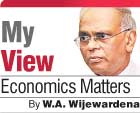A top economist and Daily FT’s weekly columnist W.A. Wijewardena is cautioning against the sharp rise in commercial and non-concessionary borrowings, which he estimates to be 50% of foreign debt by end this year from just 5% in 2004.
According to Wijewardena, as per his weekly column on Page 15 in today’s issue, the ratio of commercial and non-concessionary borrowings in 2011 had risen to 43% of foreign debt from less than 5% in 2004. With the new sovereign loan of US$ 1 billion raised in July, the commercial and non-concessionary borrowing component in the total foreign borrowings is projected to rise to 50% by the end of 2012, he said.
“Given the fact that the Sri Lanka Government’s consumption expenditure exceeds its revenue thereby generating a sizable deficit in its revenue account, a part of the foreign commercial borrowings is used by the government for consumption purposes as well. Having an unaffordable consumption level by resorting to foreign commercial borrowings is not a prudent debt management policy at all,” Wijewardena opined.
As at May 2012, public debt amounted to Rs. 5.90 trillion, of which foreign debt was Rs. 2.75 trillion or 46.6%. A year ago public debt was Rs. 4.80 trillion and foreign debt was Rs. 2.07 trillion or 43%.
He said up to 2004, the country had used commercial debt from foreign markets very sparingly because, being a low income country, it had access to concessionary credit from donors and the multilateral lending institutions like the World Bank and ADB.
However, after the country graduated from low income to lower middle income country in the first decade of the new millennium, this concessionary flow of borrowing was no longer available to the country. Accordingly, Sri Lanka had to increase its borrowings from foreign commercial and non-concessionary sources.
Wijewardena also warned that the country cannot be complacent by the fact that Debt to GDP ratio being relatively low at 78% from above 100% in 2004 because actually the Government’s borrowings had gone up unrestrained though the Debt to GDP ratio had dipped, which was mainly because of the faster expansion of the nominal GDP than the debt stock. read here Wijewardena’s column which also focuses on three unsavoury features in the country’s rising public debt levels making its public borrowings a commission of Original Sin.
FT
